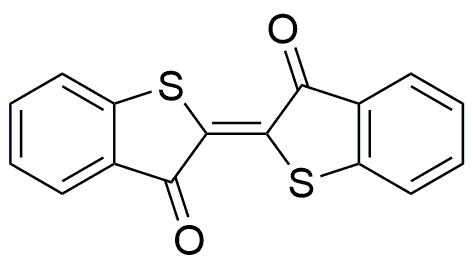Thioindigo is widely utilized in research focused on:
- Dyes and Pigments: Thioindigo is primarily known for its vibrant color properties, making it an excellent choice for textile dyes and pigments in the fashion industry.
- Organic Electronics: This compound is used in organic semiconductors, contributing to the development of flexible electronic devices such as organic light-emitting diodes (OLEDs) and solar cells.
- Pharmaceuticals: Thioindigo derivatives are explored for their potential therapeutic effects, particularly in developing new drugs for various diseases, including cancer.
- Research in Photochemistry: The compound is valuable in photochemical studies, helping researchers understand light-induced reactions and energy transfer processes.
- Material Science: Thioindigo is investigated for its properties in creating advanced materials, including polymers and nanocomposites, enhancing durability and performance.
General Information
Properties
Safety and Regulations
Applications
Thioindigo is widely utilized in research focused on:
- Dyes and Pigments: Thioindigo is primarily known for its vibrant color properties, making it an excellent choice for textile dyes and pigments in the fashion industry.
- Organic Electronics: This compound is used in organic semiconductors, contributing to the development of flexible electronic devices such as organic light-emitting diodes (OLEDs) and solar cells.
- Pharmaceuticals: Thioindigo derivatives are explored for their potential therapeutic effects, particularly in developing new drugs for various diseases, including cancer.
- Research in Photochemistry: The compound is valuable in photochemical studies, helping researchers understand light-induced reactions and energy transfer processes.
- Material Science: Thioindigo is investigated for its properties in creating advanced materials, including polymers and nanocomposites, enhancing durability and performance.
Documents
Safety Data Sheets (SDS)
The SDS provides comprehensive safety information on handling, storage, and disposal of the product.
Product Specification (PS)
The PS provides a comprehensive breakdown of the product’s properties, including chemical composition, physical state, purity, and storage requirements. It also details acceptable quality ranges and the product's intended applications.
Certificates of Analysis (COA)
Search for Certificates of Analysis (COA) by entering the products Lot Number. Lot and Batch Numbers can be found on a product’s label following the words ‘Lot’ or ‘Batch’.
Número de catálogo
Número de lote/lote
Certificates Of Origin (COO)
This COO confirms the country where the product was manufactured, and also details the materials and components used in it and whether it is derived from natural, synthetic, or other specific sources. This certificate may be required for customs, trade, and regulatory compliance.
Número de catálogo
Número de lote/lote
Safety Data Sheets (SDS)
The SDS provides comprehensive safety information on handling, storage, and disposal of the product.
DownloadProduct Specification (PS)
The PS provides a comprehensive breakdown of the product’s properties, including chemical composition, physical state, purity, and storage requirements. It also details acceptable quality ranges and the product's intended applications.
DownloadCertificates of Analysis (COA)
Search for Certificates of Analysis (COA) by entering the products Lot Number. Lot and Batch Numbers can be found on a product’s label following the words ‘Lot’ or ‘Batch’.
Número de catálogo
Número de lote/lote
Certificates Of Origin (COO)
This COO confirms the country where the product was manufactured, and also details the materials and components used in it and whether it is derived from natural, synthetic, or other specific sources. This certificate may be required for customs, trade, and regulatory compliance.


